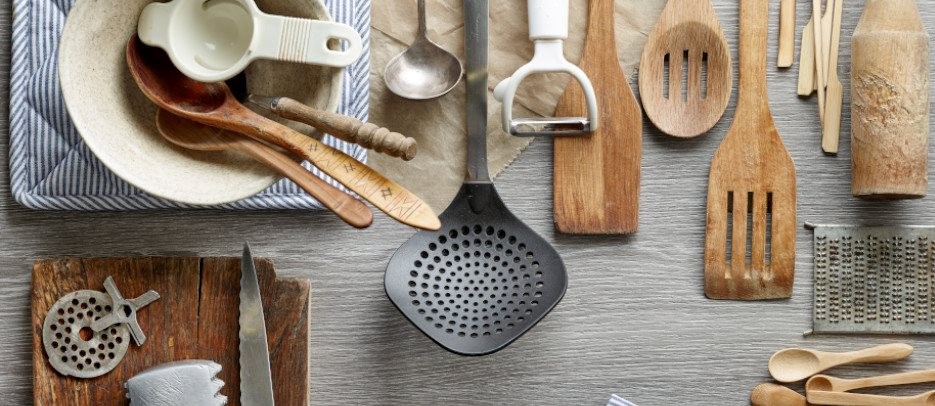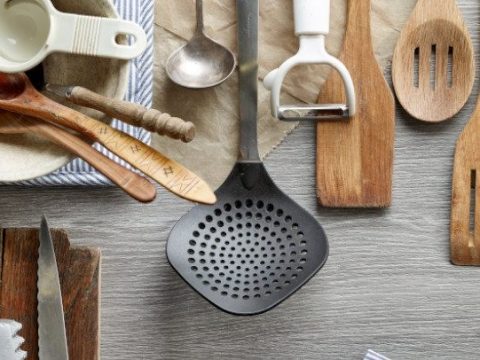Smart Cleaning Tips for Your Kitchen Tools
Maintaining a clean kitchen isn’t just about hygiene—it’s about health. Bacteria and food residues on cooking tools can end up directly in your meals. Every material requires a different approach, so here’s a comprehensive guide to cleaning your kitchen accessories by type.
How to Clean Common Kitchen Tools
Blender Blades and Knives
Add a drop of dish soap and warm water into the blender, turn it on for 15–20 seconds, then rinse. Done!
Graters
Clean immediately after use using a kitchen brush. Wash with dish soap and rinse thoroughly.
Wooden Utensils
Wood is porous and traps food particles and bacteria. Scrub immediately after use with a stiff sponge and quality dish soap. Rinse under hot water and allow to dry in the sun if possible.
Disinfect regularly by soaking in a solution of 1 cap of bleach and 20 caps of water for 1 hour. To eliminate bleach odor, rub with lemon and salt, then air dry.
Never leave wooden tools soaking overnight—they’ll crack and become breeding grounds for bacteria.
Plastic Tools and Containers
Plastic is easy to clean unless coated in grease. Soak overnight in a mix of dish soap, baking soda, vinegar, and lemon juice for better results.
Aluminum
Aluminum stains over time. Boil 1 liter of water with lemon salt to restore shine, or boil with vinegar. Dry thoroughly. Avoid abrasive sponges.
Glass Tools
Soak dirty glassware for 1–2 hours. To remove water or hand marks, wipe with a mix of vinegar, water, and rubbing alcohol. Great for mirrors and windows too.
Knives
Wash and dry immediately after use to prevent rust. Store in a wooden or magnetic holder. Clean thoroughly near the handle, where bacteria may accumulate.
Occasionally disinfect with hot vinegar or a bleach solution.
Sticker Residue
Peel off what you can. Soak a cloth and leave on the sticker for 2–3 minutes. For metal, glass, or ceramic: apply oil or acetone to soften residue. For porous materials like wood: use rubbing alcohol and dry with a hair dryer. Warm air melts adhesive on most materials.
What to Use for Cleaning
Essential Cleaning Ingredients
- Apple cider vinegar
- Lemons
- Baking soda
- Salt
Lemon Cleaner
Rub kitchen tools with half a lemon, let the juice sit for 30 minutes, then rinse.
DIY Liquid Dish Soap
Mix: juice from 2–3 lemons, 2–3 tablespoons baking soda, 1 cup vinegar, and 2 cups water. Shake well and use for cleaning greasy or smelly tools. Let soak overnight, then rinse thoroughly.
Degreasing with Baking Soda
Use dry baking soda as a scouring powder, or mix with lemon juice for a natural abrasive cleaner.
Grease Stains on Fabric
Apply salt or baking soda to oily spots. Let sit for 10–15 minutes before washing.
Burnt Food? Try Cola!
Soak burnt pans in cola for a few hours, then clean as usual. Alternatively, boil water with detergent in the pan, let cool, then scrub.
Disinfection by Boiling
Boiling tools (except plastic, fragile glass, or porcelain) kills bacteria. Use it for toothbrushes and most durable items.
General Kitchen Hygiene Tips
- Replace sponges, cloths, and brushes regularly.
- Disinfect sink, trash bin, and countertops weekly.
- To unclog drains: pour 2–3 tablespoons of baking soda into the drain, wait, then flush with boiling water.
Final Thought
Keep your kitchen stocked with lemons, vinegar, and baking soda—and clean your tools regularly. It’s the secret to a healthy kitchen and long-lasting utensils.


